White Gold Commences Diamond Drilling on Flagship High Grade White Gold Project
globenewswire.com
August 06, 2025 07:00 ET | Source: White Gold Corp.
TORONTO, Aug. 06, 2025 (GLOBE NEWSWIRE) -- White Gold Corp. (TSX.V: WGO, OTCQX: WHGOF, FRA: 29W) (the “Company”) is pleased to announce the commencement of Phase II of its 2025 Exploration Program. Phase II is focused on advancing high-priority gold targets across its flagship White Gold Property in Yukon, Canada, with the aim of expanding the existing multi-million-ounce high grade gold resource(1) and enhancing the project’s technical understanding for future development. This work forms part of the Company’s 2025 exploration program on its extensive and underexplored land package in the prolific White Gold District, Yukon, supported by strategic partner Agnico Eagle Mines Limited.
Building on Phase I momentum (see Company press release dated July 28, 2025) aimed at advancing multiple critical metals targets across the Company’s district-scale portfolio, for which the Company is arranging accretive corporate opportunities to unlock the potential value of these critical mineral projects, Phase II is focused on the Company’s continued advancement of its significant gold assets (Figure 1). The planned work is in the immediate vicinity of the Company’s defined resources (Figure 2), with significant growth opportunities also identified across multiple additional targets also located in close proximity to the existing resources.
Phase II 2025 Exploration Program Highlights:
- Diamond Drilling: Diamond drilling planned at the Golden Saddle zone is set to target a high-grade footwall breccia identified in historic drilling (Figures 3-5). Previous drilling was extended far enough to discover this zone, however it remains largely unexplored. This presents an exciting opportunity to increase known mineralization and expand the resource estimate as these areas are within or close to the existing pit shell and remain open in multiple directions.
- Relogging & Resampling: Gold mineralization has recently been observed in unsampled core belonging to the footwall and hanging wall host rocks. These zones were not originally expected to host mineralization and were not assayed in historical drilling. To evaluate the presence of additional mineralization, a targeted program to relog and resample historic drill core will focus on delineating mineralization trends in the hanging wall and footwall of the Golden Saddle Zone, an area with strong potential for additional resource growth.
- Metallurgical & Geotechnical Sampling: Additional metallurgical and geotechnical test work across the Arc and Golden Saddle Zones to advance technical understanding in support of a Preliminary Economic Assessment.
- Upcoming Webinar: Join CEO David D’Onofrio and Vice-President of Exploration Dylan Langille on Thursday, August 7th, at 11 AM ET / 8 AM PT for a corporate update and an overview of White Gold Corp’s 2025 exploration campaign. An open question & answer session will follow the presentation. Register Here: globenewswire.com
2025 Exploration Program – Phase II
Significant expansion opportunity has been identified on the White Gold Project. The diamond drilling planned for Phase II is focused on the Golden Saddle Zone which remains open in multiple directions and at depth with drilling to date intersecting significant widths of high grade near-surface gold mineralization. Historic core relogging and resampling will further evaluate mineralization potential in areas adjacent to the main deposit envelope that were previously underexplored. These activities are designed to define and further expand the known resources and define new drill targets in support of future resource updates.
“Our Phase II program is focused on efficiently expanding the size and confidence of our flagship resource,” stated Dylan Langille, Vice President of Exploration. “In addition to our diamond drilling, the relogging and resampling of historic core is an important step towards unlocking overlooked mineralization in the hanging wall, while the metallurgical and geotechnical test work will support future development pathways. This is just a few of the numerous opportunities that exist to continue to increase the size of the resources at the White Gold Project.”
“With Phase II now underway, we are excited to build on our proven track record of discovery and resource growth in the White Gold District,” stated David D’Onofrio, Chief Executive Officer. “We believe our flagship gold assets have the potential to become a tier 1 project in Canada and provide a strong foundation for value creation. We are also optimistic that our systematic exploration methodology, which has been so successful to date, will deliver continued success with additional new discoveries in our underexplored district scale land package.”
White Gold Corp’s property portfolio includes 15,362 quartz claims across 21 properties covering 300,000 hectares (3,000 km2), representing approximately 40% of the White Gold District and hosts numerous prospective gold and critical mineral targets in addition to the Company’s flagship White Gold Project which comprises 1,203,000 ounces of gold in the Indicated Resource category (17.7 million tonnes Mt averaging 2.12 g/t Au) and 1,116,600 ounces of gold in the Inferred Resource category (24.5 Mt averaging 1.42 g/t Au)(1) and remains open for further expansion. Additional increases to the size of the resource may also be possible through an ongoing analysis to incorporate mineralization hosted within the Company’s Target for Further Exploration (“TFFE”) area that hosts an additional estimated 10 – 12 million tonnes grading between 1 – 2 g/t Au, based on drilling in these areas and current geologic models. The size of the TFFE has been determined by examining the unmodelled drill hole intercepts and assuming a modest continuity of grade of the unmodelled intercepts. The potential quantity and grade is conceptual in nature as there has been insufficient exploration to define a mineral resource in this area and that it is uncertain if further exploration will result in the target being delineated as a mineral resource.
Maps outlining the Company’s phase II 2025 exploration programs and target-specific maps are accompanying this news release and can be found at globenewswire.com.
Photos accompanying this announcement are available at:
globenewswire.com
Unlocking Additional Resource Potential & Continuing to Deliver Value in a Tier-1 Jurisdiction
The Golden Saddle deposit is hosted within a package of metamorphosed quartz-feldspar-muscovite schists belonging to the Yukon-Tanana Terrane and is spatially associated with a series of steeply dipping shear zones. These structures have acted as key conduits for gold-bearing hydrothermal fluids, particularly along lithologic contacts and structural intersections, and remain largely underexplored at depth. The Golden Saddle deposit itself is primarily associated with a northeast-trending shear zone, which continues westward into the Golden Saddle West target, where limited drilling has already confirmed potential for parallel zones of mineralization. Immediate expansion opportunities are present in the hanging wall and footwall zones, where historic drilling and relogging efforts have highlighted potential for additional high-grade mineralization. Expansion of the Golden Saddle Main zone remains open along strike (East-West) as well as at depth along a potential high grade plunge corridor dipping approximately 50 degrees toward west (261). Beyond the main deposit area, the Ryan’s Trend — located approximately 2 km west of Golden Saddle — hosts multiple targets, including Ryan’s Surprise and Ulli’s, where drilling has intersected significant near-surface gold mineralization within a parallel structural corridor. This trend remains open along its entire length and continues to be a priority for follow-up exploration with several untested targets. Further afield, the Company’s adjacent QV property offers additional growth potential, highlighted by the VG deposit — which shares similar geology to Golden Saddle — and the underexplored Chris Creek target, both of which lie along prospective structures with strong geochemical and geophysical signatures and hosts several other untested targets. Together, these zones form a cohesive network of high-potential targets across the White Gold and QV properties which together form the White Gold Project.
Resources & Opportunities in the White Gold District
West-central Yukon is host to several highly prospective mineral districts, including the White Gold, Dawson Range, Klondike, and Sixtymile districts. The Klondike was the epicenter of the historic Klondike Gold Rush in 1896, with over 20 million ounces of placer gold production having occurred in the region since that time.
The Company’s property portfolio, which covers large portions of the White Gold District, was assembled by renowned prospector Shawn Ryan, and represents the largest contiguous claim package in the region.
Two significant advanced-stage projects border the Company’s claims to the south:
- The Coffee Project, owned by Newmont Corporation, hosts Measured and Indicated Resources of 50.2 Mt grading 1.28 g/t Au for 2.17 million ounces of gold, and Inferred Resources of 6.7 Mt grading 1.14 g/t Au for 0.23 million ounces gold(3) (4).
- The Casino Project, owned by Western Copper and Gold Corporation, contains Measured and Indicated Resources of 2,490.7 Mt grading 0.18 g/t Au, 0.14% Cu for 14.8 million ounces of gold and 7.6 billion pounds of copper, and Inferred Resources of 1.4 Mt grading 0.14 g/t Au, 0.14% Cu for 6.3 million ounces of gold and 3.1 billion pounds of copper(5)(4).
The region has seen significant investment by major mining companies in recent years, and the Yukon is consistently ranked among the top 10 global mining jurisdictions on the Fraser Institute’s Investment Attractiveness Index.
All four of White Gold’s near-surface deposits, which form the White Gold Project, are interpreted to represent structurally controlled orogenic gold systems. These deposits collectively form the Company’s gold resource base in the heart of its extensive land package and remain open for expansion. Additional information on each of these deposits can be found below.
Golden Saddle Deposit
The Golden Saddle deposit is located 95 km south of Dawson City on the Company’s White Gold property, which is supported by the fully operational Thistle exploration camp with airstrip and barge access, and up to 100-person capacity. The deposit consists of the GS Main, GS Footwall and GS West zones and together the zones define mineralization over a 1,500 m strike length and up to 725 m down dip. Currently, the GS Main is the most significant zone in terms of estimated ounces and overall grade, containing approximately 95% of the Indicated ounces within the overall Golden Saddle deposit.
Gold mineralization at the Golden Saddle deposit is hosted in a meta-volcanic and meta-intrusive assemblage broadly consisting of felsic orthogneiss, amphibolite, and ultramafic units. Gold generally occurs as micron-scale blebs along fractures or encapsulated by pyrite, and as visible gold (less than 5 mm in size) located as free grains in quartz. Mineralization is present in quartz veins and stockwork or breccia with disseminated pyrite. Drill hole intersected gold mineralization is spatially co-incident with structures, and structures or faults which are interpreted to be the primary conduits for hydrothermal fluids responsible for gold deposition. The thicknesses of the mineralization and breccia zones are variable from 5 m to over 50 m, and they pinch and swell along strike. A consistent higher-grade core (> 3 g/t Au) occurs within the main zone at Golden Saddle. Gold mineralization at the Golden Saddle deposit remains open along strike and at depth and is known to extend beyond the limits of the current resource estimate; however, the mineralization in these areas does not currently meet the criteria to be classified as Mineral Resources.
Arc Deposit
The Arc deposit is located approximately 400 m south of the Golden Saddle and consists of two zones, the Arc Main and Arc Footwall zones, both trending E-NE and dipping to the north at approximately 50 degrees. Mineralization at Arc has been defined over 1,200 m in strike length and up to 450 m down dip with mineralization open along strike and down dip. Gold mineralization at the Arc deposit is less well understood than the Golden Saddle, which is partially a function of drilling at the Arc deposit being more widely spaced. Gold mineralization is hosted within a meta-sedimentary sequence dominated by banded (graphitic) quartzite and interbedded pelitic biotite schist that is cross-cut by numerous felsic to intermediate dikes and sills.
Gold mineralization appears to be focused within breccia and shear zones that have been affected by hydrothermal alteration and sulphide mineralization. Drilling has defined an upper main zone as well as a lower footwall zone of anomalous gold but of lesser tenure than the main upper zone. Mineralization remains open to the east, west and at depth. The occurrence of gold at Arc appears to be associated with disseminated and veined pyrite, arsenopyrite and graphite.
Ryan’s Surprise Deposit
Ryan’s Surprise is located 1.5 km west of the Golden Saddle deposit, along a 6.5 km long x 1 km wide north-northwest trend of anomalous gold and arsenic in soils (“Ryan’s Trend”), which also hosts several other prospective early-stage targets in close proximity with significant surface gold mineralization and represent further potential for expansion of this project. Gold mineralization at the Ryan’s Surprise deposit is primarily hosted within a meta-sedimentary sequence dominated by banded (graphitic) quartzite and interbedded pelitic biotite schist cross-cut by numerous felsic – intermediate dikes and sills.
Gold mineralization appears to be focused within breccia and shear zones that have been affected by hydrothermal alteration and sulphide mineralization. Recent drilling has defined multiple subparallel zones that are host to gold-bearing sulphide mineralization including arsenopyrite and pyrite, and range in true width from < 1 m to in some instances, > 10 m. The mineralization footprint at the Ryan’s Surprise deposit measures approximately 550 m north-south by 500 m east-west to a vertical depth of 650 m remains open along strike and at depth. Metallurgical work and gold characterization and deportment studies are required to further determine accurate gold recoveries. However, host rocks, alteration and sulphide mineralization at Ryan’s Surprise display many similarities to the Arc Deposit.
VG Deposit
The VG deposit is located approximately 85km south of Dawson City and 11km north of the Golden Saddle deposit. Gold mineralization at the VG deposit is hosted in quartz ± carbonate veins, stockwork and breccia zones, and pyrite veinlets, including cubic pyrite and visible gold, associated with intense-quartz-carbonate-sericite alteration, pervasive K-spar and hematite emplaced along en-echelon faults or shear zones. Visually, the style of gold mineralization and alteration appears identical to the Golden Saddle deposit, along with similar dominant host rocks of biotite-feldspar (± augen)-quartz gneisses. To date, no metallurgical testwork has been performed on the VG mineralization; however, given its close similarities to Golden Saddle, gold recoveries are assumed to be similar. Opportunities exist at the VG deposit to quickly upgrade a significant portion of Inferred Resources to Indicated, as well as for expansion of gold mineralization at depth and along strike. There are also several other prospective targets, including the 5.2 km long Chris Creek trend (see Company press release dated February 27, 2025), on the property which have received limited exploration work and offer potential for additional discoveries.
Qualified Person
Steven Walsh, P.Geo. and Senior Geologist for the Company is a “qualified person” as defined under National Instrument 43-101 – Standards of Disclosure of Mineral Projects and has reviewed and approved the content of this news release.
About White Gold Corp.
The Company owns a portfolio of 15,364 quartz claims across 21 properties covering approximately 300,000 hectares (3,000 km2) representing approximately 40% of the Yukon’s emerging White Gold District. The Company’s flagship White Gold project hosts four near-surface gold deposits which collectively contain an estimated comprises 1,203,000 ounces of gold in the Indicated Resource category (17.7 million tonnes averaging 2.12 g/t Au) and 1,116,600 ounces of gold in the Inferred Resource category (24.5 million tonnes averaging 1.42 g/t Au)(1). Regional exploration work has also produced several other new discoveries and prospective targets on the Company’s claim packages which border sizable gold discoveries including the Coffee project owned by Newmont Corporation with Measured and Indicated Resources of 50.2 Mt grading 1.28 g/t Au for 2.17 million ounces of gold, and Inferred Resources of 6.7 Mt grading 1.14 g/t Au for 0.23 million ounces gold(3)(4), and Western Copper and Gold Corporation’s Casino project which has Measured and Indicated Resources of 2,490.7 Mt grading 0.18 g/t Au, 0.14% Cu for 14.8 million ounces of gold and 7.6 billion pounds of copper, and Inferred Resources of 1.4 Mt grading 0.14 g/t Au, 0.14% Cu for 6.3 million ounces of gold and 3.1 billion pounds of copper(5)(4). For more information, visit www.whitegoldcorp.ca.
(1) See White Gold Corp. technical report titled “2024 Technical Report for the White Gold Project, Dawson Range, Yukon, Canada”, Effective Date October 28, 2024, Report Date January 3, 2025, NI 43-101 Compliant Technical Report prepared by Dr. Gilles Arseneau, P.Geo., available on SEDAR+.
(2) Allan, M.M., Mortensen, J.K., Hart, C.J.R., Bailey, L.A., Sánchez, M.G., Ciolkiewicz, W., McKenzie, G.G. and Creaser, R.A., 2013, Magmatic and Metallogenic Framework of West-Central Yukon and Eastern Alaska: Society of Economic Geologists, Special Publication 17, pp. 111-168.
(3) See Newmont Corporation Form 10-K: Annual report for the year ending December 31, 2023, in the Measured, Indicated, and Inferred Resources section, dated February 29, 2024, available on EDGAR. Reserves and resources disclosed in this Form 10-K have been prepared in accordance with the Regulation S-K 1300, and do not indicate NI43-101 compliance.
(4) The QP has been unable to verify the information. The information is not necessarily indicative to the mineralization on the properties that are subject of the disclosure.
(5) See Western Copper and Gold Corporation news release titled “Western Announces Positive Feasibility Study on the Casino Project”, dated July 10, 2023. The resource estimates are based on the NI 43-101 compliant technical report filed on SEDAR+ with an effective date of July 3, 2023. (6) All numbers are rounded. Overall numbers may not be exact due to rounding.
Qualified Person
Steven Walsh, P.Geo. and Senior Geologist for the Company is a “qualified person” as defined under National Instrument 43-101 – Standards of Disclosure of Mineral Projects and has reviewed and approved the content of this news release.
Cautionary Note Regarding Forward Looking Information
This news release contains "forward-looking information" and "forward-looking statements" (collectively, "forward-looking statements") within the meaning of the applicable Canadian securities legislation. All statements, other than statements of historical fact, are forward-looking statements and are based on expectations, estimates and projections as at the date of this news release. Any statement that involves discussions with respect to predictions, expectations, beliefs, plans, projections, objectives, assumptions, future events or performance (often but not always using phrases such as "expects", or "does not expect", "is expected", "anticipates" or "does not anticipate", "plans", “proposed”, "budget", "scheduled", "forecasts", "estimates", "believes" or "intends" or variations of such words and phrases or stating that certain actions, events or results "may" or "could", "would", "might" or "will" be taken to occur or be achieved) are not statements of historical fact and may be forward-looking statements. In this news release, forward-looking statements relate, among other things, the Company’s objectives, goals and exploration activities conducted and proposed to be conducted at the Company’s properties; future growth potential of the Company, including whether any proposed exploration programs at any of the Company’s properties will be successful; exploration results; and future exploration plans and costs and financing availability.
These forward-looking statements are based on reasonable assumptions and estimates of management of the Company at the time such statements were made. Actual future results may differ materially as forward-looking statements involve known and unknown risks, uncertainties and other factors which may cause the actual results, performance or achievements of the Company to materially differ from any future results, performance or achievements expressed or implied by such forward-looking statements. Such factors, among other things, include: the expected benefits to the Company relating to the exploration conducted and proposed to be conducted at the White Gold properties; failure to identify any additional mineral resources or significant mineralization; the preliminary nature of metallurgical test results; uncertainties relating to the availability and costs of financing needed in the future, including to fund any exploration programs on the Company’s properties; business integration risks; fluctuations in general macroeconomic conditions; fluctuations in securities markets; fluctuations in spot and forward prices of gold, silver, base metals or certain other commodities; fluctuations in currency markets (such as the Canadian dollar to United States dollar exchange rate); change in national and local government, legislation, taxation, controls, regulations and political or economic developments; risks and hazards associated with the business of mineral exploration, development and mining (including environmental hazards, industrial accidents, unusual or unexpected formations pressures, cave-ins and flooding); inability to obtain adequate insurance to cover risks and hazards; the presence of laws and regulations that may impose restrictions on mining and mineral exploration; employee relations; relationships with and claims by local communities and indigenous populations; availability of increasing costs associated with mining inputs and labour; the speculative nature of mineral exploration and development (including the risks of obtaining necessary licenses, permits and approvals from government authorities); the unlikelihood that properties that are explored are ultimately developed into producing mines; geological factors; actual results of current and future exploration; changes in project parameters as plans continue to be evaluated; soil sampling results being preliminary in nature and are not conclusive evidence of the likelihood of a mineral deposit; title to properties; ongoing uncertainties relating to the COVID-19 pandemic; and those factors described under the heading "Risks Factors" in the Company’s annual information form dated July 29, 2020 available on SEDAR+. Although the forward-looking statements contained in this news release are based upon what management of the Company believes, or believed at the time, to be reasonable assumptions, the Company cannot assure shareholders that actual results will be consistent with such forward-looking statements, as there may be other factors that cause results not to be as anticipated, estimated or intended. Accordingly, readers should not place undue reliance on forward-looking statements and information. There can be no assurance that forward-looking information, or the material factors or assumptions used to develop such forward-looking information, will prove to be accurate. The Company does not undertake to release publicly any revisions for updating any voluntary forward-looking statements, except as required by applicable securities law.
Neither the TSXV nor its Regulation Services Provider (as that term is defined in the policies of the TSXV) accepts responsibility for the adequacy or accuracy of this news release.
For Further Information, Please Contact:
Contact Information:
David D’Onofrio
Chief Executive Officer
White Gold Corp.
(647) 930-1880
ir@whitegoldcorp.ca

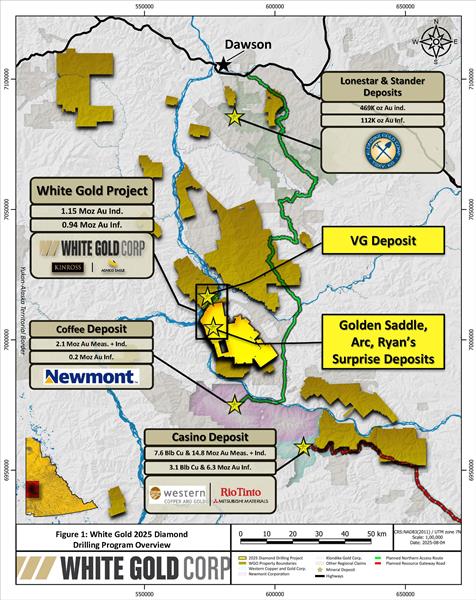 Figure 1: White Gold 2025 Diamond Drilling Program Overview Figure 1: White Gold 2025 Diamond Drilling Program Overview Figure 1: White Gold 2025 Diamond Drilling Program Overview Figure 1: White Gold 2025 Diamond Drilling Program Overview 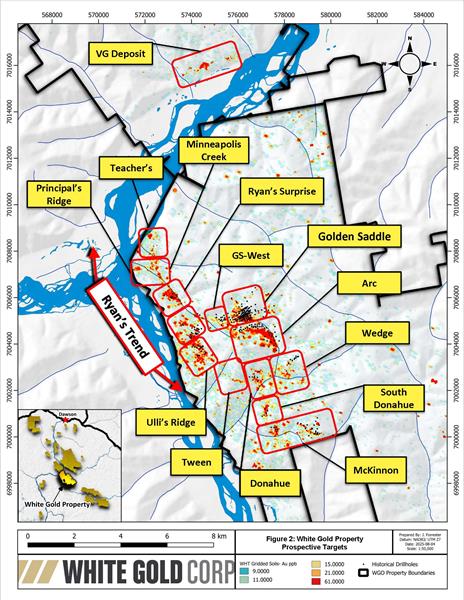 Figure 2: White Gold Property Prospective Targets Figure 2: White Gold Property Prospective Targets Figure 2: White Gold Property Prospective Targets Figure 2: White Gold Property Prospective Targets 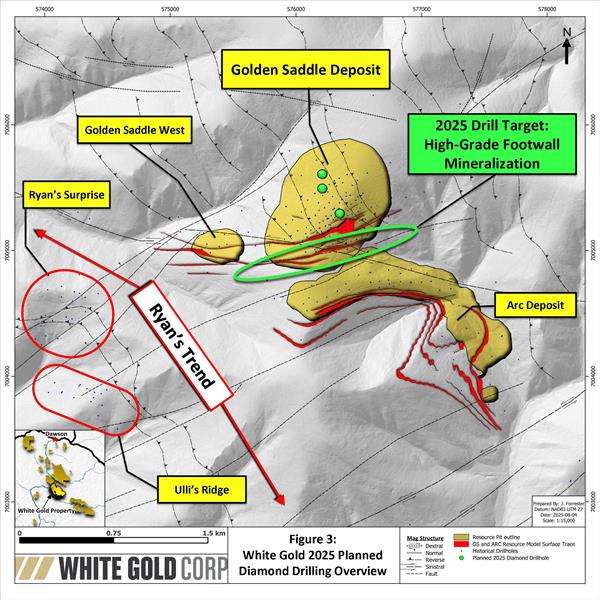 Figure 3: White Gold 2025 Planned Diamond Drilling Overview Figure 3: White Gold 2025 Planned Diamond Drilling Overview Figure 3: White Gold 2025 Planned Diamond Drilling Overview Figure 3: White Gold 2025 Planned Diamond Drilling Overview 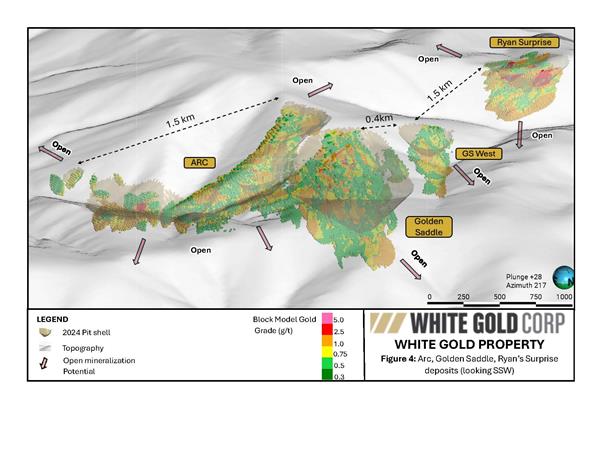 Figure 4: Arc, Golden Saddle, Ryan’s Surprise deposits (looking SSW) Figure 4: Arc, Golden Saddle, Ryan’s Surprise deposits (looking SSW) Figure 4: Arc, Golden Saddle, Ryan’s Surprise deposits (looking SSW) Figure 4: Arc, Golden Saddle, Ryan’s Surprise deposits (looking SSW) 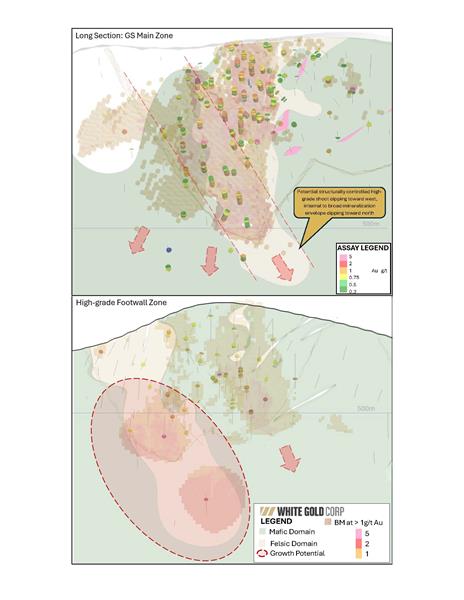 Figure 5 Figure 5 Figure 5 Figure 5
|





